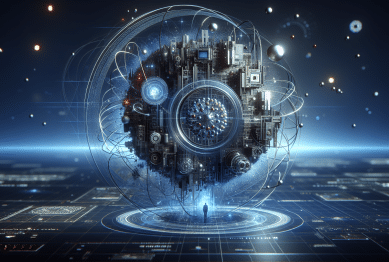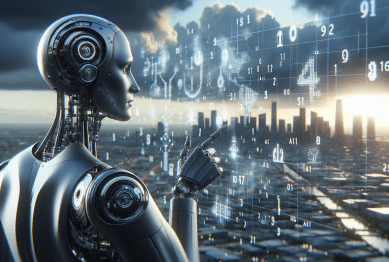Artificial intelligence is everywhere—from voice assistants to smarter healthcare solutions. This article unpacks where AI is already part of daily life, what opportunities and questions it brings, and which innovations might surprise even longtime tech enthusiasts.
The Role of Artificial Intelligence in Modern Technology
Artificial intelligence (AI) has become an essential tool in technology, rapidly influencing how businesses, healthcare, and entertainment sectors operate. Whether it’s the autocomplete in your search engine or the recommendation engines on streaming platforms, AI shapes digital experiences all day long. Many people interact with AI systems every time a virtual assistant answers a question or a photo is automatically tagged online. This integration into daily technology enables companies to process massive amounts of data and improve personalized services, making devices smarter and more adaptive. AI systems offer a wide array of solutions, from automated translations to detecting patterns in cybersecurity. AI’s ability to learn and evolve earns it a prominent place in discussions about the future of innovation (Source: https://www.nist.gov/artificial-intelligence).
Across industries, the integration of AI isn’t just about convenience—it’s also about efficiency and scale. Healthcare professionals, for example, leverage machine learning models to aid in complex diagnoses, while cities employ smart technology powered by AI to improve traffic flow and energy management. Research consistently shows that the adoption of AI can lead to more responsive customer experiences and faster decision-making processes. As software evolves, its AI-driven capabilities improve, whether it’s through more accurate voice recognition, natural language processing, or advanced predictive analytics. The effects are visible, tangible, and ever-expanding in more corners of society.
Interest in machine learning and neural networks has surged, with many businesses creating dedicated teams focused on experimenting with AI strategies. Machine learning’s capacity for self-improvement helps companies detect market trends, anticipate demand, and optimize logistics. Startups and tech giants alike use AI algorithms in various ways—from authenticating online identities to powering autonomous vehicles. More than just a buzzword, AI is a backbone of modern progress. It changes how people interact with devices, and sparks curiosity about what lies ahead in fields such as robotics and computer vision.
Everyday Experiences: AI in Your Daily Life
For most people, AI is less a distant concept and more a quiet helper throughout daily routines. Consider smartphones—digital assistants respond to spoken queries, translate languages on the fly, and suggest calendar appointments based on email content. In social media, AI algorithms recognize faces, filter content, and help tailor news feeds. These systems have transformed how users experience digital platforms, making everything more personalized. Many major retailers also harness AI-powered chatbots to manage customer service inquiries, saving time and resources while providing users with efficient support (Source: https://ai.gov/).
The home experience is evolving, too. Smart speakers and connected devices predict preferences, change music, and control lighting through learning routines. Wearable devices analyze sleep patterns and activity levels, providing steady feedback for wellness improvements. All of this depends on AI’s ability to handle data and make decisions in near real time. Grocery delivery apps, ride-sharing services, and even spam filters in communications all rely on machine intelligence for smooth, effective outcomes. AI keeps life organized and manageable—often in subtle ways people don’t even realize.
Navigation apps are another everyday example. They route drivers based on live traffic conditions using continuously updated data. AI maps construction, traffic jams, and other incidents to deliver the best route possible. Similarly, financial applications use AI-powered credit scoring, fraud detection, and budgeting recommendations. Even weather forecasting services are leveraging AI, allowing for more precise and timely updates. As the technology becomes more seamless, it quietly redefines what people can expect from the devices and platforms they interact with on a regular basis.
Opportunities Created by Machine Learning
Businesses of all sizes are awakening to the value of machine learning for analyzing vast quantities of data and drawing actionable conclusions. With machine learning, organizations can automate complex processes, spot patterns in customer behavior, and anticipate likely outcomes. Financial institutions, for instance, use AI to monitor transactions for suspicious activity, increasing security and reducing risk. In marketing, personalized product recommendations driven by AI have fueled increases in customer engagement and satisfaction. This results in more tailored offerings, benefiting both consumers and providers (Source: https://hbr.org/2019/07/the-potential-and-pitfalls-of-artificial-intelligence).
Machine learning isn’t all about commerce—it also plays a crucial role in science and research. Medical researchers use deep learning systems to identify disease markers in imaging data and predict potential health outcomes. Agricultural experts rely on AI to monitor crop health, optimize irrigation, and forecast yields with greater accuracy. Environmental scientists harness the same techniques to model climate changes and develop strategies for conservation. These advancements make machine learning a powerful ally in addressing complex global challenges.
The rise of AI-driven process automation opens up resources for human workers to focus on creative and strategic tasks. In areas such as supply chain management, AI models identify bottlenecks, predict delays, and suggest improvements. This capability helps companies stay competitive in a fast-paced market. Educational settings also benefit—AI-powered platforms can personalize learning plans for students, adapting lessons in real-time to fit individual needs. By doing so, machine learning increases opportunity, accessibility, and efficiency across multiple industries.
Challenges and Ethical Considerations in AI Adoption
With every leap in artificial intelligence comes a new set of questions about ethics, transparency, and accountability. As AI systems make more complex decisions, the need to understand and interpret how these machines reach their conclusions is pressing. Concerns over algorithmic bias and data privacy persist, prompting demand for guidelines that ensure fairness and trustworthy results. The ethical implications of AI grow as its influence spreads, demanding careful consideration from policy makers, developers, and users alike (Source: https://www.brookings.edu/research/what-is-artificial-intelligence/).
One of the most debated challenges is algorithmic transparency. People want assurance that AI-powered services, such as loan approval or healthcare diagnostics, operate without hidden biases. Researchers are working actively to design more interpretable machine learning systems, building trust by making AI’s decision-making pathways visible. There’s also growing interest in ensuring AI is used responsibly—avoiding discriminatory outcomes, managing data securely, and giving users clearer choices over how algorithms affect their lives. Such principles help guide innovation toward positive impact.
Balancing innovation and regulation is crucial. If rules are too rigid, progression slows, and society misses out on potential benefits. If oversight is too lax, public trust may erode, and harm can occur. International groups and technology organizations are publishing recommended best practices to navigate these complexities. These resources help inform laws and offer blueprints for responsible AI use going forward. As AI becomes more ingrained in society, ethical guidance remains essential in shaping its future role.
Future Trends and Innovations in AI
The continuous advance of AI brings possibilities that once seemed the domain of science fiction. Quantum computing, for example, could one day enable AI systems to solve currently impossible problems, accelerating breakthroughs in drug discovery, logistics, and cryptography. Researchers also predict major progress as AI joins forces with the Internet of Things (IoT), connecting billions of devices that communicate and optimize smart homes, cities, and even industries. Natural language processing—already impressive—continues to improve, making machines better conversation partners in more languages and dialects (Source: https://www.technologyreview.com/2020/04/13/999226/artificial-intelligence-explained/).
Another trend shaping AI is the acceleration of edge computing, where models run locally on devices rather than in distant data centers. This brings faster, more private, and energy-efficient AI experiences. Self-driving cars are a headline example—vehicles equipped with AI sensors and advanced computer vision analyze surroundings in milliseconds, improving road safety. Advances in robotics will also create new interactions between people and machines, from assistive care in hospitals to collaborative industrial robots in manufacturing.
Greater public involvement drives the conversation about AI’s direction. Educational initiatives introduce students to AI concepts early, inspiring a new generation of innovators. Increasingly, citizens participate in shaping how AI is developed and used, via public consultations and open-source projects. The result? A future where AI not only powers new devices but also reflects the values and priorities of broader society. As AI technology evolves, people everywhere watch—and influence—what happens next.
Getting Started: How to Learn More About Artificial Intelligence
Learning about artificial intelligence can feel overwhelming, but many accessible resources make it easier to grasp the basics. Introductory online courses, like those offered by major educational platforms, demystify AI concepts and cover topics such as supervised learning and data analysis. Interactive workshops, podcasts, and university-hosted events encourage hands-on exploration. Anyone curious about the field can start with free materials that are concise, approachable, and designed for all backgrounds (Source: https://ocw.mit.edu/courses/electrical-engineering-and-computer-science/6-034-artificial-intelligence-fall-2010/).
Several public organizations publish guides and insights about AI’s societal impact, helping people understand evolving innovations. The National Institute of Standards and Technology, for example, outlines AI’s risks and opportunities, while nonprofit research institutions regularly provide plain-language reports. Groups like AI4ALL and the Partnership on AI create programs to broaden participation and understanding, emphasizing diversity in AI’s future development. This ensures a well-rounded conversation, involving professionals and everyday users alike.
Experimenting with AI tools online allows direct engagement without any special expertise. Beginner-friendly platforms offer code-free environments to run basic machine learning experiments or explore how recommendation engines work. Libraries and meetup groups can also connect those interested in AI with likeminded learners, sparking curiosity and knowledge-sharing. As resources expand, it’s easier than ever for anyone to join the worldwide journey toward understanding artificial intelligence and its growing influence.
References
1. National Institute of Standards and Technology. (n.d.). Artificial Intelligence. Retrieved from https://www.nist.gov/artificial-intelligence
2. United States Government. (n.d.). Artificial Intelligence. Retrieved from https://ai.gov/
3. Bessen, J., & Rouse, C. (2019). The Potential and Pitfalls of Artificial Intelligence. Harvard Business Review. Retrieved from https://hbr.org/2019/07/the-potential-and-pitfalls-of-artificial-intelligence
4. West, D. M. (n.d.). What is Artificial Intelligence? Brookings Institution. Retrieved from https://www.brookings.edu/research/what-is-artificial-intelligence/
5. MIT Technology Review. (2020). Artificial Intelligence Explained. Retrieved from https://www.technologyreview.com/2020/04/13/999226/artificial-intelligence-explained/
6. Massachusetts Institute of Technology. (n.d.). Artificial Intelligence (6.034) Fall 2010. MIT OpenCourseWare. Retrieved from https://ocw.mit.edu/courses/electrical-engineering-and-computer-science/6-034-artificial-intelligence-fall-2010/









